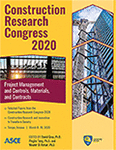Construction Research Congress 2020
Case Study of Efficiency Improvements Using Matrix Methods of Production Management in Building Construction
Publication: Construction Research Congress 2020: Project Management and Controls, Materials, and Contracts
ABSTRACT
Construction delays may result from poor planning by construction managers, or from improper alignment of field production management with the project schedule. These issues can be avoided by implementing a schedule-aligned production management system that is visually evident and easily manageable for all trade supervisors and all levels of management. This paper presents the clear flow matrix (CFMx), a novel and simple production control technique employing a two-dimensional matrix to depict schedule compliant field production. The paper provides a case study of the CFMx used as a recovery schedule on a behind-schedule building construction project. The case study compares the field application of the CFMx with the CPM-based production control system originally used on the lagging project, confirming the utility of an easily understood method in maintaining planned production. Interviews of trade contractor personnel were used to assess supervisor opinions of the usefulness of the CFMx in building construction projects. Further assessment of the CFMx included labor time utilization data from Work Sampling Analysis of CFMx projects in comparison with labor utilization data obtained from the construction industry.
Get full access to this article
View all available purchase options and get full access to this chapter.
REFERENCES
Behnam, A., Harfield, T. & Kenley, R. (2016). “Construction management scheduling and control: the familiar historical overview.” Proceedings of the 4th International Building Controls Conference, 7-8 March 2016, Kuala Lumpur.
Binninger, M., Dlouhy, J., and Haghsheno, S. (2019). “Flow in Takted Projects – A Practical Analysis of flow and Resource Efficiency.” In: Proc. 27th Annual Conference of the International. Group for Lean Construction (IGLC), Pasquire, C. and Hamzeh, F.R. (ed.), Dublin, Ireland, pp. 1271-1282.
Birrell, G. (1980). “Construction Planning - Beyond the Critical Path.” Journal of the Construction Division., ASCE, 106(3), 389-407.
Gill, P. (1968). Systems management techniques for builders and contractors. New York. McGraw-Hill.
Gong, J., Borcherding, J., & Caldas, C. (2010). “Assessment of direct work utilization at the workface in the US Construction Industry.” Construction Research Congress 2010: Innovation for Reshaping Construction Practice, (pp. 960-969).
Hanna, Awad (2004). “The Stacking of Trades.” https://www.ecmag.com/section/your-business/stacking-trades (April 3, 2019).
Henrich, G., Tilley, P. & Koskela, L. (2005). “Context of production control in construction.” 13th Int. Group for Lean construction Conf. Sydney, Australia.
Henrich, G. Koskela, L. (2005). “Why does production management fail in construction?” International Postgraduate Conference, Salford, UK.
Haghsheno, S., Binninger, M., Dlouhy, J. and Sterlike, S. (2016). “History and Theoretical Foundations of Takt Planning and Takt Control.” Proc. 24th Ann. Conf. of the Int.Group for Lean Construction, Boston, MA, USA, pp. 53–62.
Kenley, R., & Seppänen, O. (2010). Location-based management for construction: Planning, scheduling and control. London: Spon Press.
Sacks, R. (2016). “What Constitutes Good Production Flow in Construction?” Construction Management and Economics 34 (9), 641-656.
Shingo, S. (1989). A Study of the Toyota Production System from an Industrial Engineering Viewpoint. Boca Raton, CRC Press, Taylor and Francis Group
Tafazzoli, M. & Shrestha, P. (2017). “Factor Analysis of Construction Delays in the U.S. Construction Industry.” 53rdASC Annual In.t Conf Proceedings.
Information & Authors
Information
Published In
Construction Research Congress 2020: Project Management and Controls, Materials, and Contracts
Pages: 612 - 621
Editors: David Grau, Ph.D., Arizona State University, Pingbo Tang, Ph.D., Arizona State University, and Mounir El Asmar, Ph.D., Arizona State University
ISBN (Online): 978-0-7844-8288-9
Copyright
© 2020 American Society of Civil Engineers.
History
Published online: Nov 9, 2020
Published in print: Nov 9, 2020
Authors
Metrics & Citations
Metrics
Citations
Download citation
If you have the appropriate software installed, you can download article citation data to the citation manager of your choice. Simply select your manager software from the list below and click Download.
